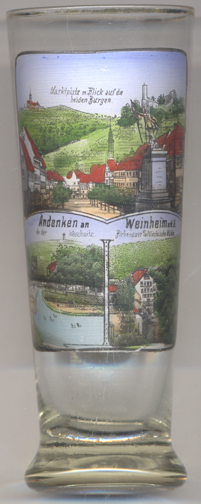

|
| DEUTSCHLAND | GERMANY |
| Bundesland: Baden-Württemberg | |
| Regierungsbezirk: Karlsruhe | |
| Landkreis: Rhein-Neckar-Kreis |
Weinheim is situated at an elevation of 135 m on the Bergstraße theme route on the western rim of the Odenwald region in the north west of Germany's state of Baden-Württemberg, about 15 km north of Heidelberg and 10 km northeast of Mannheim. Together with these cities, it makes up the Rhine-Neckar triangle. It has the nickname "Zwei-Burgen-Stadt", or Two-Castle city ('Burg' means 'fortress'), named after the two fortresses on the hill overlooking the town. The municipality has a population of about 44,800 (2015).
 The earliest record of Weinheim dates back to 755 AD, when the name Winenheim was recorded in the
Lorsch codex, the record book of Lorsch Abbey.
In 1000 AD, Emperor Otto III bestowed Weinheim the right to hold markets, and in 1065 the right to mint and
issue coins. A new town developed next to the old town from 1250. In 1308, the old town was transferred to the
Electorate of the Palatinate. From 1368 onwards the whole town belonged to the Electorate of the Palatinate and
the Heidelberg Oberamt district since the end of the 14th century. With the transfer to Baden in 1803, Weinheim
became the seat of its own Amt, which was unified with Landkreis Mannheim in 1936. From 1938 onwards Weinheim
belonged to Landkreis Mannheim until 1 January 1973, when the Rhein-Neckar-Kreis was formed.
The earliest record of Weinheim dates back to 755 AD, when the name Winenheim was recorded in the
Lorsch codex, the record book of Lorsch Abbey.
In 1000 AD, Emperor Otto III bestowed Weinheim the right to hold markets, and in 1065 the right to mint and
issue coins. A new town developed next to the old town from 1250. In 1308, the old town was transferred to the
Electorate of the Palatinate. From 1368 onwards the whole town belonged to the Electorate of the Palatinate and
the Heidelberg Oberamt district since the end of the 14th century. With the transfer to Baden in 1803, Weinheim
became the seat of its own Amt, which was unified with Landkreis Mannheim in 1936. From 1938 onwards Weinheim
belonged to Landkreis Mannheim until 1 January 1973, when the Rhein-Neckar-Kreis was formed.
 Wachenburg castle [top picture: background top left]
was built between 1907 and 1928 by the Weinheimer Senioren-Convent, a Corps of former students.
The castle contains a restaurant with a nice view of the country.
Wachenburg castle [top picture: background top left]
was built between 1907 and 1928 by the Weinheimer Senioren-Convent, a Corps of former students.
The castle contains a restaurant with a nice view of the country.
 Windeck castle [top picture: background top right]
was built around 1100 to protect the monastery of Lorsch. It was hugely damaged in 1674 by French troops.
In 1960, the ruins were restored, the palace walls newly erected and the donjon safeguarded. In 1978, the ruins
were acquired by the city of Weinheim. In the 1980s, archaeological examinations and conservation works
were carried out, discovering the entire ground plan, which gave an idea of the former dimensions of the fortress.
Today, the ruins are protected as a historical monument.
Windeck castle [top picture: background top right]
was built around 1100 to protect the monastery of Lorsch. It was hugely damaged in 1674 by French troops.
In 1960, the ruins were restored, the palace walls newly erected and the donjon safeguarded. In 1978, the ruins
were acquired by the city of Weinheim. In the 1980s, archaeological examinations and conservation works
were carried out, discovering the entire ground plan, which gave an idea of the former dimensions of the fortress.
Today, the ruins are protected as a historical monument.
The  soldier's monument in market Square [top picture: far right]
was created in 1890 by the sculptor Georg Heitmann from Karlsruhe.
Already soon after its creation it was noted that the cast zinc sculpture began to show damages.
However, being made of zinc rather than bronze saved the monument from being melt down during World War II.
During a estauration in the 1970s, the metal casings were filled with resin and fiber-glass, reinforced by an
interior steel structure. However, over the years, the steel began to corrode and the resin started to go brittle.
In 2009, the state of the sculpture had become so alarmming that a thorough restauration had to be carried out.
soldier's monument in market Square [top picture: far right]
was created in 1890 by the sculptor Georg Heitmann from Karlsruhe.
Already soon after its creation it was noted that the cast zinc sculpture began to show damages.
However, being made of zinc rather than bronze saved the monument from being melt down during World War II.
During a estauration in the 1970s, the metal casings were filled with resin and fiber-glass, reinforced by an
interior steel structure. However, over the years, the steel began to corrode and the resin started to go brittle.
In 2009, the state of the sculpture had become so alarmming that a thorough restauration had to be carried out.
The bottom left picture shows a view of
a section of the  Weschnitz
Weschnitz
The bottom right picture shows a view of
the  Fuchs'sche Mühle
Fuchs'sche Mühle
[https://en.wikipedia.org/wiki/Weinheim, https://de.wikipedia.org/wiki/Weinheim;
https://en.wikipedia.org/wiki/Wachenburg, https://en.wikipedia.org/wiki/Windeck_Castle_(Weinheim);
https://www.google.at/url?sa=t&rct=j&q=&esrc=s&source=web&cd=1&ved=0ahUKEwi12qbW1LvPAhVCVhQKHRI-ArIQFggeMAA&url=https%3A%2F%2Fjournals.ub.uni-heidelberg.de%2Findex.php%2Fnbdpfbw%2Farticle%2FviewFile%2F12240%2F6083&usg=AFQjCNFwiq4mVn4sqZwA8rKXrRCgYjKkDA&sig2=EwCg2YF5YZK0DxE5ITwTxw&cad=rja;
http://www.fuchssche-muehle.de/index.php?id=31]
![[scale]](lineal.jpg)